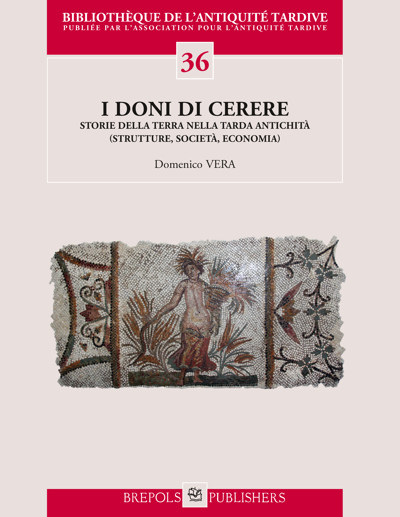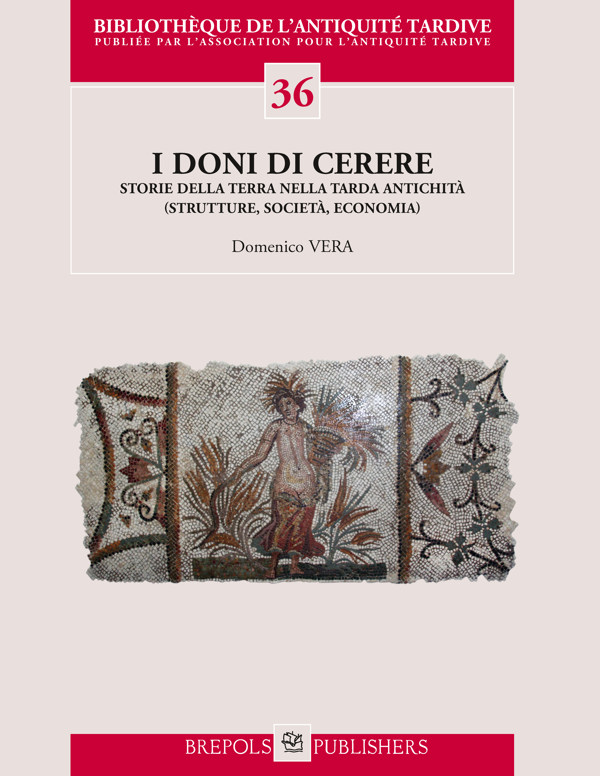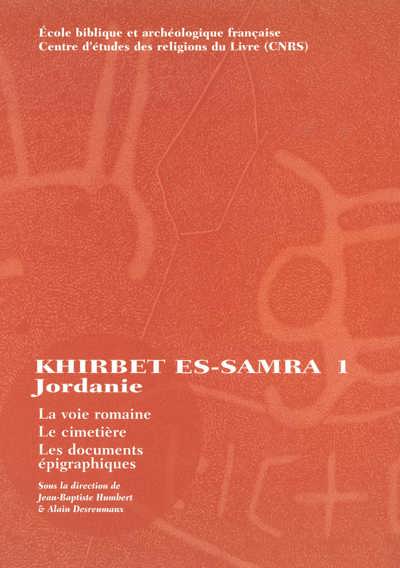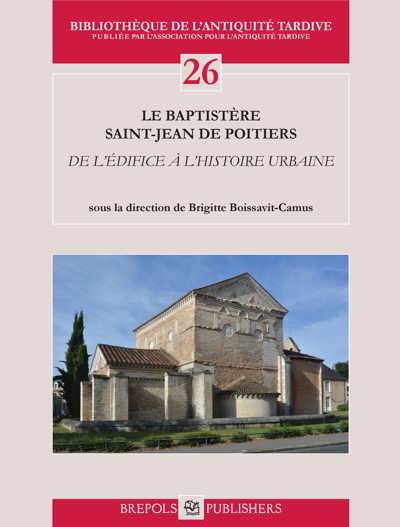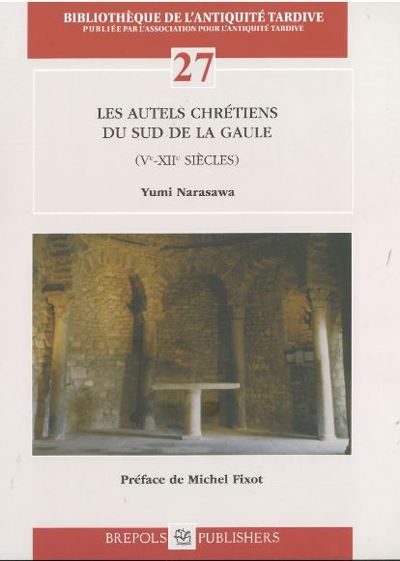
I doni di Cerere. Storie della terra nella tarda antichità
(Strutture, società, economia)
Domenico Vera
- Pages: 389 p.
- Size:216 x 280 mm
- Illustrations:1 b/w, 0 col., 2 tables b/w.
- Language(s):Italian, French, English
- Publication Year:2020
- € 80,00 EXCL. VAT RETAIL PRICE
- ISBN: 978-2-503-58150-7
- Paperback
- Available
Domenico Vera, une nouvelle écriture de l'histoire agraire
Domenico Vera est né en 1945 dans la province de Foggia (Pouilles septentrionales). En 1966-1970, il a étudié aux universités de Pavie, puis de Turin (laureato en 1971) où il a été le premier véritable disciple de Lellia Cracco Ruggini. Il a enseigné, successivement, à Trieste de 1977 à 1986, puis à partir de cette date, à Parme où il a exercé les plus hautes responsabilités administratives et scientifiques de la Faculté de Lettres et Philosophie. Il est émérite depuis 2015. Son œuvre scientifique couvre les aspects majeurs de l’histoire romaine tardive, avec une concentration particulière sur l’histoire économique. Il dirige la collection « Munera » créée par lui en 1994 chez l’éditeur Edipuglia de Bari.
Even if his wide-ranging research work is not limited to Roman agrarian history, this is the field in which his contribution has been decisive and internationally recognized. For this reason, Domenico Vera chose this theme when he planned to gather in a single coherent volume a number of texts that first appeared in not easily accessible publications.
The critical examination to which he submitted the sources over the years enabled him to radically renew the account that was traditionally given of the late imperial rural world, at opposite ends of the self-sufficiency that was posited by the 19th century historians, while revisiting the chronology of its implementation. Domenico Vera challenges an alleged break in the Italian agricultural flourishing throughout the 2nd and 3rd centuries as well as an alleged continuity from the 4th-6th centuries colonate up to medieval serfdom, or the prefiguration of the large Carolingian estate as soon as the Later Roman Empire.
Domenico Vera clearly identified those three main features which make a difference in agrarian structures before and after the 3rd century: “deconcentration of production (hence the prevalence of colonate)”; “indirect land management (hence the expansion of a multi-level tenancy system)”; “concentration of the rent and surplus held by the landlords (hence the decline of the banking professions) and the tendency to the overlapping of great landlordship and wholesale trade”. From now on Italian agrarian economy and society organised themselves around two antithetic but non-adversarial poles: the land barons and an authentic “peasant society”.
This volume aims at giving to more readers easier access to key texts some of which were published in hardly available journals or conference proceedings.
Bien que son œuvre scientifique, aux multiples versants, ne se limite pas à l’histoire agraire romaine, c’est ce thème où son apport a été déterminant et internationalement reconnu que Domenico Vera a retenu pour réunir en un volume homogène des textes dispersées dans des publications souvent difficiles d’accès.
Le travail critique sur les sources qu’il a mené au fil des ans l’a conduit à renouveler radicalement le tableau traditionnellement offert du monde rural tardoimpérial, aux antipodes de l’autarcie postulée par les historiens du XIXe siècle, et à bouleverser la chronologie de sa mise en place. Domenico Vera récuse aussi bien une prétendue rupture de la prospérité agricole italienne au cours des IIe-IIIe siècles qu’une prétendue continuité entre le colonat des IVe-VIe siècles et le servage médiéval, ou la préfiguration, dès l’Empire tardif, du grand domaine carolingien.
Domenico Vera a clairement identifié les trois traits principaux qui différencient les structures agraires de part et d’autre du IIIe siècle : « déconcentration de la production (d’où la prédominance du colonat) » ; « gestion foncière indirecte (d’où l’expansion d’un système de location à plusieurs étages) » ; « concentration de la rente et du surplus entre les mains des propriétaires (d’où le déclin des métiers de la banque et la tendance à la superposition de la grande propriété et du commerce de gros ». L’économie et la société agraire italienne s’organisent désormais autour de deux pôles antithétiques mais non contradictoires : les magnats de la terre et une véritable « peasant society ».
Le présent volume se propose de rendre accessibles à un plus vaste lectorat des textes fondamentaux publiés parfois dans des revues ou des actes de colloques peu diffusés.
Avant-propos. Domenico Vera, une nouvelle écriture de l'histoire agraire (J.-M. Carrié)
Prefazione
Bibliografia di Domenico Vera (1973-2018)
1. Appunti per una storia della proprietà fondiaria nel tardo impero
2. Strutture agrarie e strutture patrimoniali nella tarda antichità: l'aristocrazia romana fra agricoltura e commercio
3. Forme e funzioni della rendita fondiaria nella tarda antichità
4. Simmaco e le sue proprietà: struttura e funzionamento di un patrimonio aristocratico del quarto secolo d.C.
5. Enfiteusi, colonato e trasformazioni agrarie nell'Africa Proconsolare del tardo impero
6. Terra e lavoro nell'Africa romana
7. Conductores domus nostrae, conductores privatorum. Concentrazione fondiaria e redistribuzione della ricchezza nell'Africa tardoantica
8. Schiavitù rurale e colonato nell'Italia imperiale
9. Proprietà terriera e società rurale nell'Italia gotica
10. L'Italia agraria nell'età imperiale: fra crisi e trasformazione
11. Dalla villa perfecta alla villa di Palladio: sulle trasformazioni del sistema agrario in Italia fra Principato e Dominato
12. Padroni, contadini, contratti: realia del colonato tardoantico
13. Le forme del lavoro rurale: aspetti della trasformazione dell'Europa romana fra tarda antichità e alto medioevo
14. I silenzi di Palladio: osservazioni sull’ultimo agronomo romano
15. Massa Fundorum. Forme della grande proprietà e poteri della città in Italia fra Costantino e Gregorio Magno
16. La legislazione sul colonato tardoantico: cui prodest?
17. I paesaggi rurali nel Meridione tardoantico: un bilancio consuntivo e preventivo
18. L’altra faccia della luna: la società contadina nella Sicilia di Gregorio Magno
19. Essere “schiavi della terra” nell’Italia tardoantica: le razionalità di una dipendenza
20. Questioni di storia agraria tardoromana: schiavi, coloni, villae
21. Imperial estates in Late Roman southern Italy: land concentration and rent distribution
Indice
